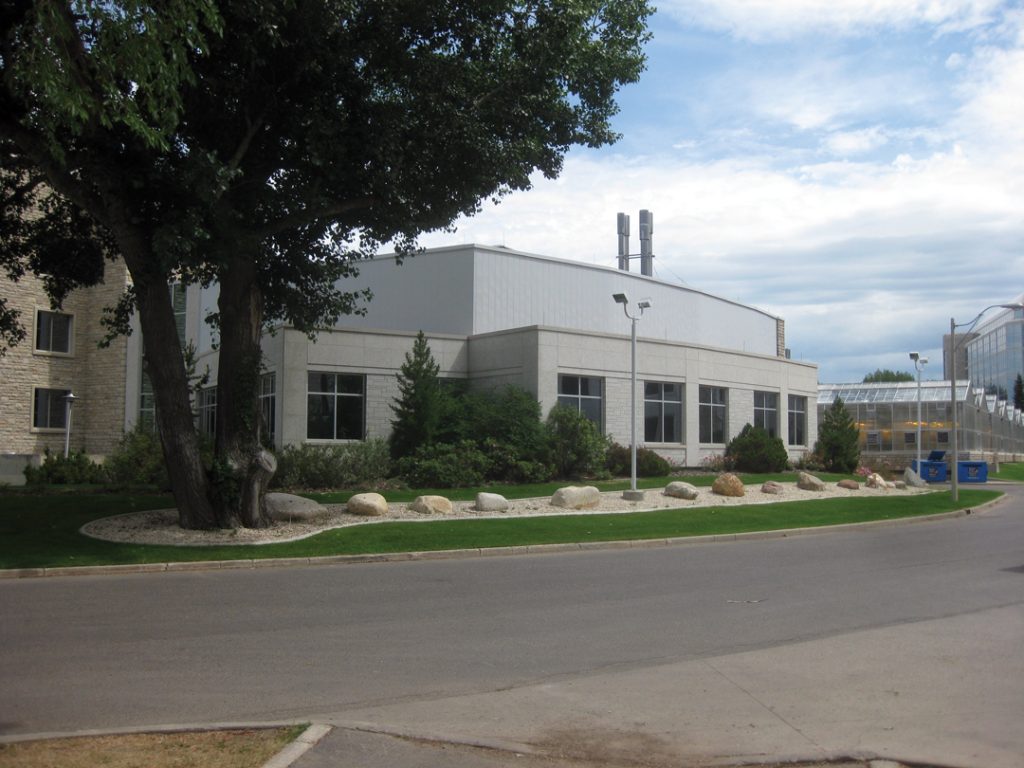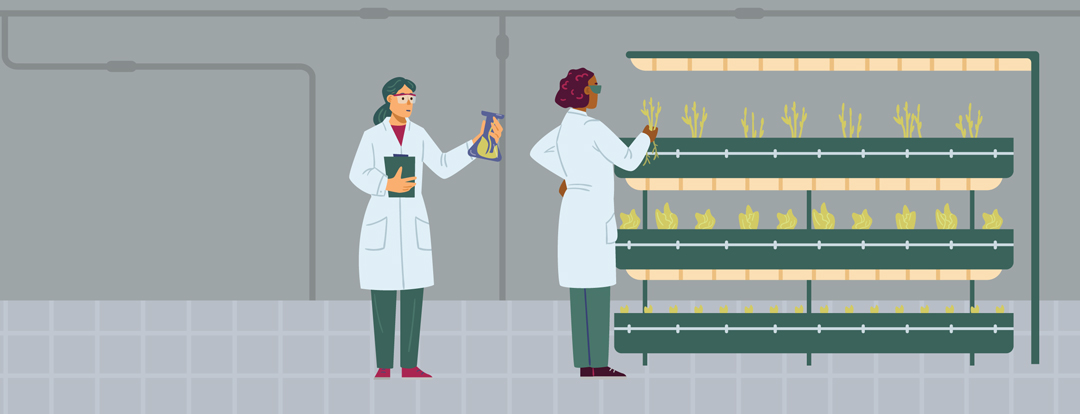VARIETY SHOW
BY KAITLIN PACKER BERGER • ILLUSTRATION: SHUTTERSTOCK
Whether it’s pernicious pests, an unpredictable climate or increasing costs, threats to cereal crops constantly evolve. To build and maintain a sustainable system for cereal production in Canada requires the ability to adapt. There are few better examples of adaptability in agriculture than the efforts made by plant breeders to assist farmers.
Breeders work hard to secure and utilize funding, physical resources and new technology to create varieties that meet ever-shifting agronomic challenges. All this to create healthy, high-yielding and profitable cereals.
“I think the whole basis for a sustainable, profitable crop production system is varieties that perform well,” said Curtis Pozniak, director of the Crop Development Centre at the University of Saskatchewan. Pozniak facilitates the Centre’s research and breeding activities, and his team continuously works to develop field-ready cultivars for western Canadian farmers.
Plant breeding is a science, and its basic principles haven’t changed since humans started to improve varieties. “At a fundamental level, plant breeders are [still] doing the same thing,” said Pozniak. “They’re intercrossing varieties, generating genetic variability, which is the basis of crop improvement, putting material into the fields and making selections for the environments they’re targeting for commercial production.”
It’s slowly getting easier for plant breeders to use genomic technologies and DNA testing. “Our understanding of the genetics of many of the traits that we’re selecting for is getting a lot better,” added Pozniak. Having that knowledge to support decisions on selection can make the breeding process more efficient. “We actually know the DNA sequence that’s causing [disease] resistance and we follow that with DNA markers and very quickly integrate that into our breeding program.”
There’s no single silver bullet technology on the plant breeding horizon that will speed the process, but continued advancement provides innovative tools essential to sustainable plant breeding. “It’s how we integrate all of those tools together in a way that’s efficient, effective and productive,” said Pozniak. “That’s really what plant breeding is about.”
Improved breeding efficiency doesn’t necessarily shorten the time it takes to get a new variety ready for commercial production. “What we have to remember is that there’s no doubt plant breeding is a multi-year endeavour, and that’s on purpose,” said Pozniak. Measuring a variety’s performance and testing it in a range of environments requires time.
Breeders have access to several tools that can help shorten the variety development process. These include double haploid technologies in wheat and speed breeding platforms that produce multiple generations per year in the greenhouse. Such methods can cut a couple of years off the traditional plant breeding window of about 10 years. “There’s an appropriate balance between efficiency, speed and performance and marketability in the product,” said Pozniak. It’s also important to note that a shorter plant breeding window doesn’t cut down the time it typically takes to field test the final product.
Rob Graf, manager of seed strategy and innovation at SeedNet and retired Agriculture and Agri-Food Canada (AAFC) wheat breeder, said Canadian plant breeding requirements have evolved to help the process become even more efficient. Kernel visual distinguishability (KVD) was eliminated in 2008. The system held that each class of wheat had its own unique size, shape and colour. To be registered, a new variety of wheat had to be physically like other varieties in its class. “That was a huge impediment in wheat breeding,” said Graf.
Before this system was scrapped, Graf said there was a period of six or seven years when no winter wheat was registered in Western Canada. If an experimental line failed to meet its KVD requirements in any one of its three years of registration testing, the line was dead, period. Now plant breeders don’t have to be concerned if the kernel has a designated shape. This opens the door to varieties that might have been previously disqualified.
Graf started as a wheat breeder in the 1980s and has worked for both public and private breeding programs over the years. One of the biggest changes he’s noticed throughout his career is how funding has evolved, particularly the impact of check-off dollars on plant breeding programs in the public sector, starting in the 1990s. “Initially, it facilitated an effective doubling in size of breeding programs, and the result was a doubling of the rate of genetic increase in yield,” said Graf. “It made a huge impact in terms of the yield gains that we’re seeing in wheat. Unfortunately, many public breeding programs are now shrinking.”
With funding from farmers through check-off dollars, plant breeders have gained access to advanced tools, but the long-term success of their work still depends on numbers. “The more plants, the more plots that you can evaluate, the greater the chances of finding those rare segregants, that needle in the haystack that is going to become the next great variety,” said Graf.
The contribution of funding by farmers became a necessary and integral part of public breeding programs. While amounts have increased over time, the costs associated with breeding programs are rising. “This a big concern to me and many in the industry, particularly with climate change,” said Graf. “Somehow, we need to find ways to invest more in plant breeding, not less.”

Alberta Grains uses check-off dollars to invest in the priorities of wheat and barley farmers. As a partner in research funding through the Canadian Wheat Research Coalition and Canadian Barley Research Coalition platforms, Alberta Grains allocates 70 per cent of its research budget to breeding projects and core breeding agreements. “By developing new varieties and hybrids with higher yields, better quality and resistance to stresses, breeding can improve the productivity and profitability of crops,” said Nasima Junejo, Alberta Grains research director.
Alberta Grains funds five major breeding programs on the Prairies. These are conducted by AAFC, the Crop Development Centre, the University of Alberta, the University of Saskatchewan and the University of Manitoba. “The commissions invest in breeding activities that enhance the sustainability of grain production,” said Junejo. Over the years, it has invested in many wheat and barley breeding projects focused on important issues. These include molecular breeding approaches for the development of elite, drought-tolerant western Canadian wheat cultivars with high water-use efficiency, as well as development of barley germplasm with improved resistance to Fusarium head blight and other biotic stresses.
“Again, all the farmer money that is collected by the various provincial commissions and now administered by the Canadian Wheat Research Coalition has made an absolutely huge difference,” said Graf. “As plant breeders, we’re thankful for the confidence that producers have in us.” The sustainability of cereal production in Canada depends on that continued trust and investment in field-ready variety development along with closely related research.
The establishment of Canada’s national plant germplasm system was another major advancement in plant breeding launched since the 1970s. While it’s not new, it offers an essential resource to plant breeders today and could play a role in solving important challenges in the future. Axel Diederichsen, curator and research scientist for the Plant Gene Resources of Canada seed germplasm system in Saskatoon, SK, said three Canadian gene banks were established to centralize collections of plant genetic material. “[We] preserve the genetic diversity as such by growing it and harvesting it, keeping plant material available,” said Diederichsen.
Cereals are the focus of the Saskatoon gene bank. They make up 80 per cent of its seed entries. Some of the plant materials are imported from other countries by researchers and plant breeders, and they’re crucial to the sustainability of cereal production in Canada. “Cereals are of key relevance; they have a long history in Canada,” said Diederichsen. Without gene banks, plant breeders would not have access to important plant material they need to pursue a sustainable future for cereals.
As the challenges of cereal production evolve, access to this collection is imperative. With an accelerated pace of change in agriculture, particularly with climate change, genetic material from areas where climate differs from our own could be more relevant than ever, said Diederichsen. “It may be that now material becomes important that was not adapted before,” he added.

“That’s what I think the main goal of plant breeding is, to be able to … adapt to the changes, the environmental conditions that are changing for us and give us a product that we can still keep moving forward with,” said Chelsea Tomlinson, a seed grower who owns and operates True Seeds with her husband Shane Wyness near Redwater.
Plant breeders can alter the genetics of cereal plants to respond better to environmental changes. “Genetics is at least half the battle in terms of sustainability,” said Lauren Comin, director of policy at Seeds Canada. “With each improvement that you make, you’re helping the crop to adapt to the conditions that you’re being faced with today, conditions that you anticipate in the future.”
As a seed grower, Tomlinson sees the need to develop varieties that keep up with an increasingly drastic swing from wet to dry environmental conditions in her region. “We’re either super wet or super dry,” she said, “In the last five years we don’t seem to have this sort of balance anymore.” The more plant breeders can focus on drought-resistant varieties, the better.
Plant breeding can alter the way a plant utilizes water, whether that’s how the roots access it or the leaves respond to it, said Comin. “There are many things you can do with genetics to allow your plant to not only grow with less but to grow more with less,” she added. “We need to ensure we’re still growing as much or more but leaving less of an environmental footprint.”
Thanks to the dedicated efforts of plant breeders who have improved its winter survival, winter wheat is a strong rotational option, and one that takes advantage of wet springs to produce higher yield. “Because you grow it in the fall, it’s able to access fall and early spring moisture that a spring-seeded crop couldn’t,” said Comin. It also helps provide ground cover during the winter to preserve essential moisture in the soil.
Another key benefit of winter wheat is that certain varieties are resistant to Fusarium head blight. With built-in resistance, it can reduce the need for chemical application, equipment passes on the field, emissions and ultimately cost. This makes it a strongly sustainable crop, added Comin.
In recent years, plant breeders have offered farmers Fusarium resistant cereal varieties beyond winter wheat. “Fusarium is the really tough one right now and we’re slowly being able to incorporate higher resistance into your varieties,” said Comin. Developing varieties resistant to Fusarium is not without its challenges, however. The plant can have resistance to initial infection, the spread of infection or the accumulation of toxin in the grain. “A lot of factors are involved, and there are a lot of genes involved in Fusarium resistance,” said Comin.
Genes have also been identified that show resistance to stripe rust, also known as yellow rust, in cereals. Because rust is a fungal disease, it evolves and adapts to overcome the defences of resistant varieties. “That has been a challenge, and that’s part of the changing climate, is changing populations and changing lifecycles of pests,” said Comin. Breeders are forced to be proactive in identifying new sources of resistance and new genes, she added.

It’s a race against the clock as pests become resistant to a crop variety’s defences. Tomlinson pointed to the very successful use of blended varieties farmers can seed at a specific rate. These refuge pairings combine a resistant variety with a similar but non-resistant one. Able to snack on a portion of the crop, the midge’s own genetics do not evolve to overcome the defences of the resistant wheat. “We’re 10 years into that program and those genetics have stayed viable,” she added.
Semi-dwarf wheat cultivars are a direct response to the need for better standability in Tomlinson’s region north of Edmonton. Traditional varieties wouldn’t have held up to the heavier fertilizer rates in use there today, but semi-dwarf varieties can handle what they’re given. They’ve also withstood significant rainfall in recent years—two or three times the normal volume of moisture according to Tomlinson. “It speeds up harvest, because we’re not trying to pick up a crop that’s flat to the ground.”
The development of semi-dwarf malting barley varieties is a similar story. In the past, an early snowfall would knock down older varieties, reducing the barley to feed quality. “You wouldn’t have a chance to maybe still get malt,” said Tomlinson. Genetics have changed the game.
With a growing world population, sustainable cereal production is more important than ever. The crops offer consumers an accessible option to other sources of plant and animal protein. “You don’t usually think of wheat being a protein crop, but it’s actually 20 per cent of global protein consumption,” said Comin. “People choose wheat products because they’re cheap.” Reducing disease, decreasing inputs and maximizing yield can keep supply strong and help ensure cereal products can remain an inexpensive form of dietary protein around the world.
Growth in the global population also shrinks the agricultural land base as cities expand. With that, farmers face pressure to reduce emissions and increase carbon sequestration while they produce high-yielding, high-quality cereals. Together with good management practices, genetics play a massive role in meeting these demands. “You can do so much more if you manage your crop based on the genetic package that you have, so understanding your genetics is really important,” said Comin. “That’s how we’re going to be able to feed the world while our agricultural lands contract.”
The possibilities of plant breeding expand as new technologies emerge. Most notably, gene editing is a technique that makes specific modifications to a cell’s DNA. “There’s a lot of things that need to be considered, including access to our international markets,” added Comin. “I hope that breeders are able to incorporate new breeding innovations like gene editing into their programs.”
The use of gene editing to incorporate disease resistance into cereals is an exciting prospect. Comin is also hopeful it can be used to manipulate the proteins involved in the gluten complex in wheat to allow people with celiac disease and gluten sensitivity to eat wheat products that contain gluten.
Tomlinson views seed farmers as playing a key part in the plant breeding chain as they are at the forefront of new variety trials. Her goal is to give commercial farmers the knowledge they require to choose the best varieties for their farms. “Each farm is dealing with different weather, different soils,” she said. Seed farmers can test out new varieties on a smaller scale before they multiply them for commercial cereal farmers to sow.
Cereal farmers constantly adapt to face growing challenges such as the increased cost of inputs, shifting climate and the emergence of new pests and diseases. Plant breeders have a similar goal. “They’re quick enough to see our problems, maybe sometimes faster than we are,” said Tomlinson. “They’re working on the solutions and then they’re ready when we do need them.”
New varieties are the backbone of sustainable cereal production, and it is plant breeders who maintain the high-quality cereal products Canada is known for. “I don’t think plant breeders are recognized or thanked often enough for what they have already given us,” said Tomlinson. “We’ve set a bar, and we want to be at this standard. They’re helping us all the time to stay at that bar, if not exceed it.”







Comments